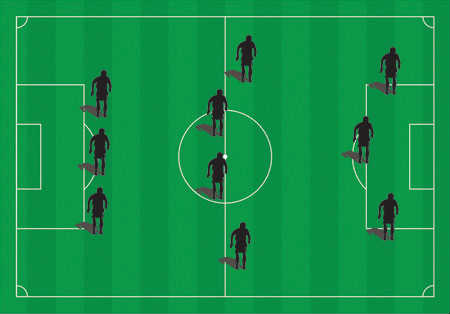Soccer teams use different kind of formation and each with its own benefits and drawbacks. Any player, even goalkeepers need to understand the structure of formations, because this could help them to predict the positioning and movements of incoming opponents. Coaches and managers are the main strategists and they need to be able to choose formations that work well, based on the strengths and weaknesses of the team.
1. Classic 4-4-2
It is typically the bread and butter of soccer formations. The classic 4-4-2 is consisted of four defenders, four midfielders and two forwards or strikers. It is a good formation that balance defense and passing, but requires very good strikers who could deliver goals effectively. The classic 4-4-2 could also work well of the two midfielders in the center also have good attacking skills. However, the 4-4-2 formation could also be designed as a defensive posture, by having midfielders with good defending skills, while still retaining reasonable attacking power. It should be noted that the 4-4-2 formation requires midfielders with good passing, attacking and tackling abilities. As the result, midfielders, especially those in the center have the highest work rate with this formation. Arsenal is known as a club that excels in 4-4-2 formation, with strong midfielders who can attack very well. With good selection of players, classic 4-4-2 is still the best formation for teams that seek to achieve a balance while holding possession for much of the time. Unfortunately, due to its popularity, any team would know how to counter this formation.
2. 4-3-3
This formation focuses more on attack, while retaining good defensive capability. This formation should work well if the team have many players with good attacking capabilities that it needs to exploit. In this formation, the attacking group is usually split into two wing forwards ad one center forward. However, the 4-3-3 formation should have an excellent midfielders group who can feed ball to the attackers with only three players. To compensate, the wing forwards could be positioned slightly on the back of the center forward, so they could still function as backup midfielders in specific situation. In general, the 4-3-3 formation is well suited for teams that focus on counter attacks. This allows as many as attackers to rush to the opponent’s area and deliver powerful shots. It should be noted that with less midfielders, the four defenders on the back need to be prepared for added pressure during defensive maneuvers. Ideally, the wing forwards should have the ability to pass the ball and set up limited forward defensive positions to make the formation becomes more balanced.
3. 5-3-2
There are weaker teams in any competition and often, they need to confront stronger teams. Therefore, it is important to adopt a defensive formation, with five defenders in the back. The 5-3-2 formation still retains adequate passing and attacking capabilities. In order to make the formation more balanced, the center defender should also have good passing skill and placed slightly forward.

